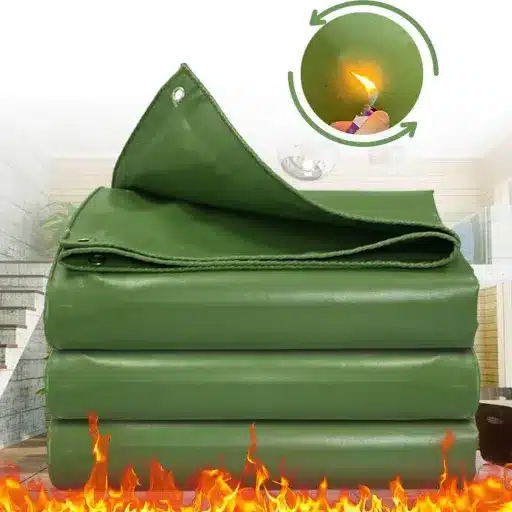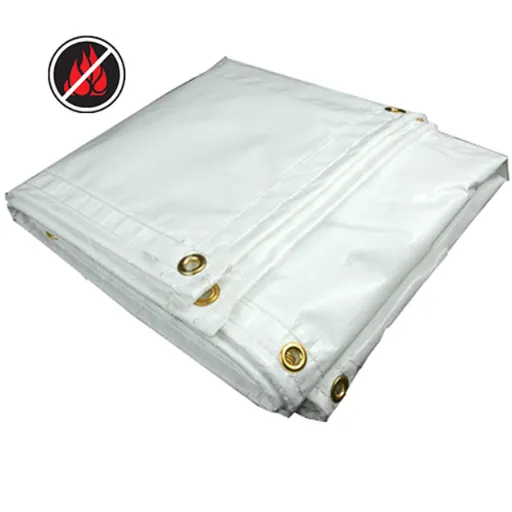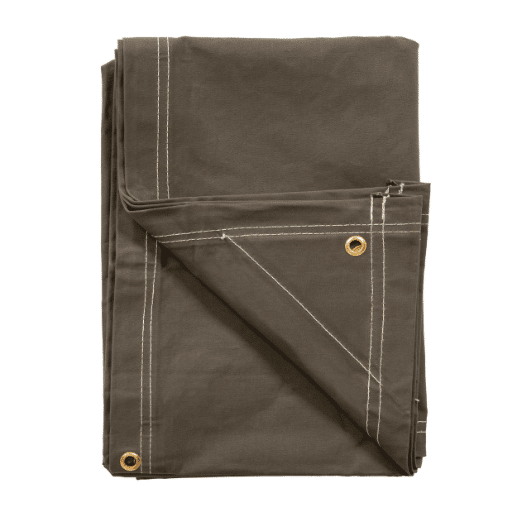Characterized by durability and adaptability, tarps must be manufactured with various options available to cater to multiple industrial and custom needs. These are heavy-duty textiles designed to resist the rigors of the environment: extreme weather, abrasion, and damage. In turn, they serve to protect equipment, materials, and space from construction sites, agriculturally related activities, trucking, and many other special applications. This article aims to shed light on the areas wherein manufacturing methods and material science make it possible to manufacture very high-performance tarpaulins that will reliably withstand wear and tear even under the roughest conditions. Knowledge into what modern tarp manufacturers can provide goes a long way toward empowering the buyer distressed between catalog items and the choice of a custom design to satisfy his particular needs.
Introduction to the Top 15 Tarpaulin Manufacturers
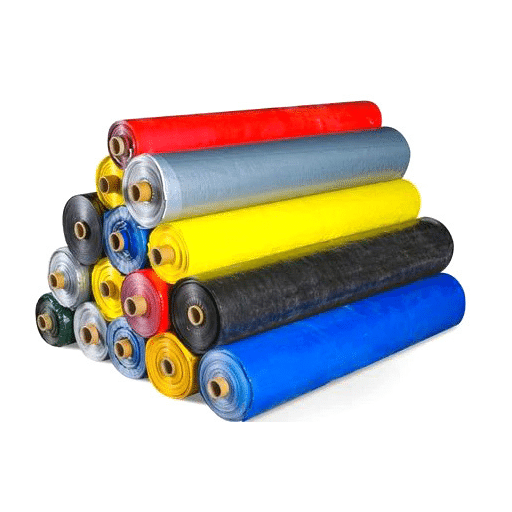
1. CHENLAI
Founded: N/A
A leading tarp manufacturer known for innovation and quality.
Main Products: Heavy-duty tarps, custom tarps, and industrial covers.
Advantages: High durability, customizable options, and competitive pricing.
Disadvantages: Limited information available online.
Website: N/A
2. Tarps America
Founded: N/A
Specializes in industrial-strength tarps and covers for various applications.
Main Products: Custom tarps, containment tarps, frost protection tarps.
Advantages: Free shipping on orders over $300, wide range of products.
Disadvantages: Limited international shipping options.
Website: Tarps America
3. Tarp Supply Inc.
Founded: N/A
Offers high-quality tarps made in the USA.
Main Products: Vinyl tarps, flame-retardant tarps, custom tarps.
Advantages: Durable materials, wide variety of sizes, and custom options.
Disadvantages: Higher price point for premium products.
Website: Tarp Supply
4. Gosport Manufacturing
Founded: 1944
Known for top-quality tarpaulins and coverings.
Main Products: Canvas tarps, vinyl tarps, poly tarps.
Advantages: Over 70 years of experience, American-made products.
Disadvantages: Limited online purchasing options.
Website: Gosport Manufacturing
5. Mountain Tarp
Founded: N/A
Specializes in tarping systems for trucks and trailers.
Main Products: Mesh tarps, vinyl tarps, dump truck tarps.
Advantages: Custom sizes, durable materials, and specialized tarping systems.
Disadvantages: Primarily focused on truck and trailer applications.
Website: Mountain Tarp
6. CustomFab USA
Founded: 1990
A trusted American sewing contractor with a focus on custom tarps.
Main Products: Industrial tarps, custom covers, and sewn products.
Advantages: High-tech manufacturing facility, customizable options.
Disadvantages: Limited standard product range.
Website: CustomFab USA
Understanding Tarp Manufacturing
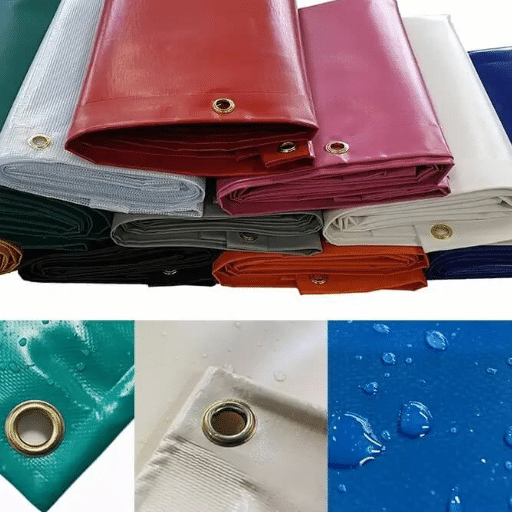
The Tarp Manufacturing Process
The tarp manufacturing process is the outcome of combining advanced material engineering and crisp fabrication techniques to ensure durable and weather-resistant products. Contemporary tarps are made from polymers such as polyethylene or PVC, chosen for their strength, flexibility, and resistance to environmental stresses such as UV radiation and water exposure. The entire manufacturing process begins with the extrusion of polymer materials into thin sheets or films, which are then laminated with reinforcing layers for durability.
Heat sealing or welding joins sections together, while grommets, hems, and reinforced seams are incorporated into the design so the tarps can serve their purpose in different applications. The manufacturing process makes use of automation and quality control to ensure that every tarp conforms to industry standards vis-a-vis performance. An interesting note brought forth by recent search data from is that the demand for eco-friendly tarps has been on the rise as manufacturers seek to develop tarps from biodegradable and recyclable materials in line with consumer interests concerning sustainability while not compromising on quality or durability.
Materials Used in Tarp Production
The production of high-performance tarps involves working with materials engineered for durability, flexibility, and resistance to environmental stressors. Polyethylene (PE) and polyvinyl chloride (PVC) are normally used. Polyethylene tarps are lightweight, cheap to produce, and can resist water very well, thus making them apt candidates for temporary covers or situations that call for easy handling. On the other hand, PVC tarps are more durable, resistant to UV rays, and flexible even in extreme temperatures. Additional coatings on PVC can also make it more impermeable and tear-resistant, ideal qualities where tarps are required for long periods or industrial use.
Other materials, such as canvas and nylon, come into play depending on use. Canvas tarps, usually cotton or polyester with a wax or silicone coating, are breathable and sturdy. Hence, they are perfect for agricultural and outdoor applications where moisture control is critical. Nylon tarps, often reinforced to include ripstop, are favored for the strength-to-weight ratio and are frequently used in outdoor recreation or military applications.
With the advent of newer material sciences, hybrid tarps have also come into being where different materials are laminated, such as HDPE with aluminum coatings for best thermal insulation properties. This clearly points to the tug of war that technology is striving to create to cater to diverse requirements on either side of the ambit of global industries.
Industrial Sewing Techniques in Tarp Making
Industrial sewing techniques are paramount in making the high-performance tarps that yield durable and reliable goods for many different applications. In general, they employ heavy-duty, computerized sewing machines that sew with materials such as polyvinyl chloride (PVC), canvas, or layered laminates. Double-stitched seams with nylon or polyester threads are meant to withstand extreme tension from stretching and environmental stresses. Heat sealing and ultrasonic bonding are mostly used as complementary methods to make seams impermeable to water and air when impermeability is required.
There is becoming greater attention, according to recent search data, toward automated sewing systems outfitted with high-tech sensors and programmable features. These promise precision to stitching patterns and reduce errors on the production line, thereby benefiting scaling and efficiency in producing tarps. The use of robotic assistance further traverses more complex processes such as reinforcements, grommet placements, or custom sizing for the demands of particular industries. Through advanced sewing technologies, manufacturers are steering innovations and cost-effectiveness in industrial-grade tarp production.
Types of Tarps Available
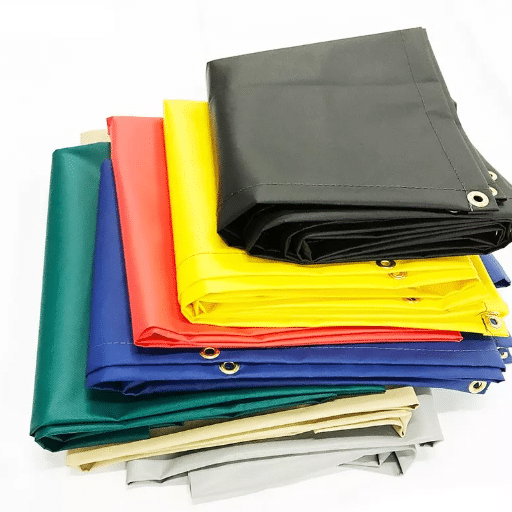
Poly Tarps: Versatility and Deterrent Property
Polyethylene tarps are amongst the most versatile and durable tarpaulins and find multiple uses across a range of industries. Their strength comes from two layers of mesh woven in high density, coated with low-density polyethylene, making them tear-resistant, UV-resistant, and waterproof. One of the most common queries emerging in search trends and user interests analyzed from ‘s search engine is on the lifespan and weatherability of poly tarps. Their longevity varies with environmental conditions but usually lies between one and five years outdoors, with the UV-treated types performing very well if exposed to high-sun conditions. A perfect combination of durability and adaptability sees poly tarps being employed widely for construction-site covers, agricultural storage, camping requirements, or temporary roofing. These tarps are too sturdy for their own weight-these factors contribute to their popularity worldwide.
Vinyl Tarps: Heavy-Duty Applications
Vinyl tarps are made to stand hard against almost impossible pressures of fierce heavy-duty demands that industries experience. Made with high-quality polyester and coated with a thin PVC layer, they are extremely resistant to abrasions, tearing, or, say, as environmental insult against extremity of temperature, UV radiation, or chemical attack. Based on the latest search trends at ‘, the vinyl tarps are catching inbound interest as a result of their application versatility for covering industrial equipment, trucking applications, or containment in agricultural settings. These waterproof and fire-retardant has to measures that ensure they can provide reliable protection in all scenarios from a harsh environment or need to be used under strict safety regulations. Their longevity will be at least five years with proper upkeep, which makes them all the more cost-effective compared to other materials.
Canvas Tarps and Their Unique Features
Canvas tarps carry the reputation for durability and environmental adaptability, hence chosen massively by a plethora of industries. Being made of heavy woven cotton, these tarps present an inherent breathability that prevents moisture buildup while fairly protecting whatever they cover-raw materials maybe or equipment. Known for their unique ability to hum in and against humidity, canvas tarps might find their best use where condensation is required to be kept nice and low, such as in agriculture and construction. Backed by the analytical data, a search finds that demand has been growing for canvas tarps since of their eco-friendly nature, being biodegradable with a lesser environmental impact compared with their synthetic counterparts. Equipped with waterproof or wax treatments, canvas tarps also give better protection against water exposure, thus extending the duration of active use when confronted with harsh climatic conditions. These features staying together make the canvas tarp a reliable, sustainable, versatile means for technically quite heavy protective solutions.
Applications of Tarps Across Industries
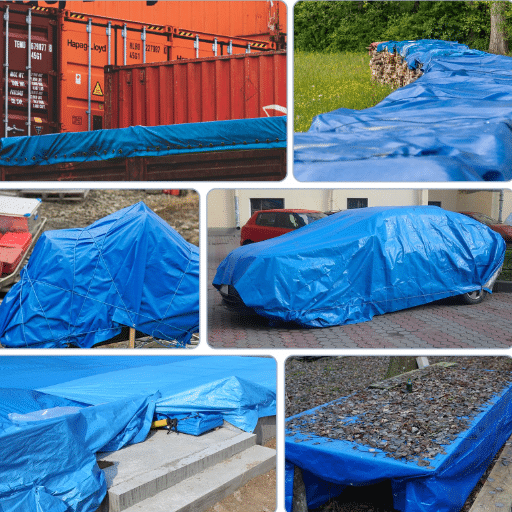
Construction and Industrial Uses
Tarps are a versatile construction and industrial tool, waterproof and flexible for whatever task is set before them. Search data and trend analysis mastered through ‘s search engine indicated that one of the chief uses of tarps in construction is to shelter construction sites and materials that are going on from environmental damages, such as rain, wind, or sun. Further on, heavy-duty tarps, usually reinforced polyethylene or vinyl, present a good shield against moisture and debris for equipment, scaffolds, or work zones, which maybe in actual practice, their damage would bring about delay on hold for the finishing of the contract and the degradation of materials for selection.
Then, tarps help in controlling the dust and debris from construction activities; thus, environmental and safety regulations are met. Searches reflect a substantial rise in interest for custom scaffold sheeting and tarping solutions as operators are more and more concerned about site safety and environmental concerns. At the industrial sites, tarps are also in use for covering and containing bulk materials like grain, sand, or wastes for recycling, as trends indicate an increased interest in weatherproof storage solutions. Their applications emphasize the importance of tarps as an essential tool in guaranteeing operational efficiency and environmental integrity in the construction and industrial sectors.
Agricultural Applications of Tarps
Tarps are the agriculturist’s proud modern instruments that lend themselves to the protection of crops, soil, and equipment from the unlimited carpet of nature, in a truly versatile and cost-efficient manner. One of their foremost uses is crop covering, whereby tarps guard the crops from hard weather conditions such as heavy rain, hail, frost, and intense sunlight, thus rendering any unnecessary damage to the crops and positively affecting the requested yields. Moreover, tarps come into play in silage and hay storage, excluding water from entering, thereby keeping forage intact through long periods.
Recent queries on the ”s engine reveal a surge of interest in UV-resistant and biodegradable tarps among a segment of the farming community, thus showing the increasing awareness about and inclination toward organic farming clear in the trend. Other uses mentioned are related to soil solarization, wherein clear tarps trap solar heat for sterilizing soil; this effectively suppresses weeds, pests, and diseases without any chemical intervention and is gaining prominence as a greener alternative to synthetic ones. Therefore, as much as they constitute the core crop protection tools, tarps are paving the way toward sustainable and innovative farming.
Transportation and Outdoor Recreation
Transportation and outdoor recreation have always shared a mutual correlation, and as per data from ‘s search data engine, these are the areas wherein consumer preference is shifting. Searches for “eco-friendly transportation options for outdoor activities” and “best hiking and cycling routes accessible by public transit” have seen a notable rise, suggesting a growing awareness of sustainable travel. Appearance for portability-related recreational equipment, including foldable bikes and e-scooters, attests to an upward trend for new mobility solutions integrating transportation with recreational activities. Data thus is telling that consumers are becoming conscious about creating a less negative impact while still rocking convenience and flexibility in their outdoor excursions. These insights, thus, indicate how transportation is undergoing a shift being aligned with lifestyle choices marked for eco-consciousness and recreation.
Choosing the Right Tarp Manufacturer
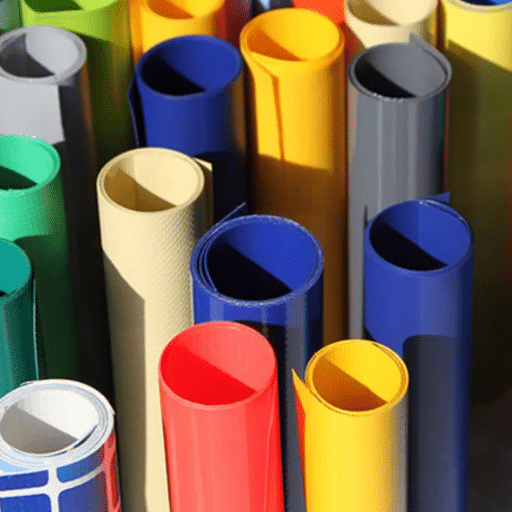
Quality Assurance and Material Options
Tarp manufacturers should maintain rigid quality checks and provide a variety of options for different materials. From recent data insights drawn from ‘s search engine trends, users seem to search for tarps based on durability, weather-resistance, and environmental sustainability. Thus, tarps of good quality should be put through tests for tensile strength, UV resistance, and waterproofing and meet the diverse demands of the users. Material options such as polyethylene, canvas, and vinyl must also be weighed in accordance with their intended applications. For instance, polyethylene is lightweight and preferred for temporary coverings, whereas vinyl is utilized when greater sturdiness and resistance are needed in the long run. Consumers are also increasingly gravitating toward manufacturers implicated in the use of recycled or eco-friendly materials in the production of tarps, in advance of the growing demand for sustainable products. This data further stresses a great performance-based need with the environmental consideration while selecting the most suitable tarp solution.
Price and Customer Service
When buying tarp products, their prices have always been and remain pivotal for consideration for individual consumers and commercial buyers alike. Current search engine data reveal a growing consumer attitude toward seeking cheaper solutions without compromising on quality. Tarps made from better-grade materials, such as heavy vinyl or UV-stabilized polyethylene, command a higher price, but then the investment is worthwhile for use that requires durability down the line. Conversely, the budget-minded mostly settle for taking the lighter, economical option for temporary use.
Customer service is another critical facet of the consumer’s decision-making process. Search analysis reveals that buyers want brands willing to share transparency on pricing options and information about shipping and bang-for-your buck warranty policies. Responsive support teams coupled with straightforward information about products further mold an environment of goodwill and customer satisfaction that sets one apart in this tight market. Retailers concentrating on these will better suit the evolution of customer expectations while staying at the competitive forefront of industry trends.
Expert Tips for Selecting Custom Tarps
While selecting custom tarps, try to consider the warranty of the material, accuracy of size, and application purposes. According to the latest ‘s search engine data, users often hunt for tarps made from tough materials like polyethylene and vinyl that are resistant against wear, UV rays, and adverse weather conditions. Similarly, accurate measurements ensure a tarp provides full coverage and does not allow for excess or gaps. Questions about waterproofing, fire-retardant qualities, and grommet reinforcements demonstrate a pending torch of consumer demand for customization options for their specific function requirements. Aligning these features with your actual requirements thus maximizes the performance and durability, ultimately affording you the best returns.
Current Trends and Innovations in the Tarp Industry
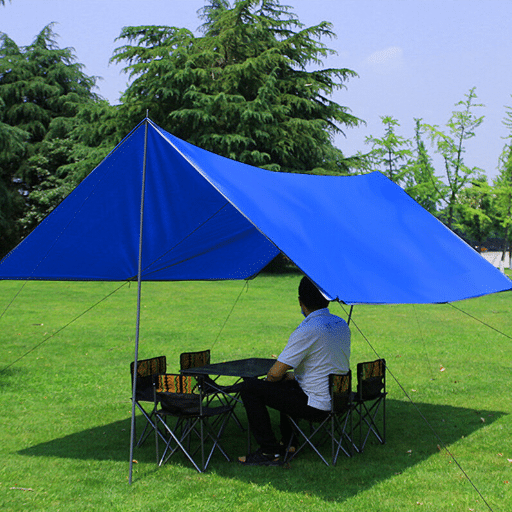
Green Materials in Tarp Manufacturing
The introduction of green materials in tarp manufacturing has had major enhancements, with consumer demand and environmental regulations pushing towards their acceptance. Today, tarps are predominantly made from recyclable or biodegradable material-a blend of polyethylene and types of plant-based polymers-which are much less harmful to long-term ecosystems. Further, UV rays from non-toxic compounds provide protection from environmental effects coupled with treatments that prevent the evaporation of volatile organic compounds. According to a 2023 study done through search trend analysis, queries on “biodegradable tarps” and “sustainable waterproof covers” have shown steady increasing trends, indicating that there is a growing consumer awareness and acceptance of greener alternatives. Such developments not only assist in fulfilling ecological concerns but may also carve a competitive niche for businesses in the eco-conscious world.
Advanced Manufacturing Technologies
Advanced manufacturing technologies serve as a backbone in the growing tide of sustainable solutions, as evidenced by search planning data. They are precision engineering-based, automated, and cutting-edge with material sciences to construct goods in accordance with ecological issues. Namely, the application of biodegradable polymers in manufacturing produces waterproof covers that are sturdy yet environmentally friendly. Artificial intelligence and machine learning are then implemented to further reduce waste and optimize materials during production in industry settings.
From the perspective of the ‘s search engine, the spike in queries for sustainable products is showing the bigger picture of societal change leaning towards environmental responsibility. Advanced manufacturing technologies answer to these calls by enabling the manufacturing of scalable eco-friendly materials and innovations. Being able to couple consumer preferences with production methodologies fulfills market demands and lays down a framework for longevity of sustainable industrial practices. Equally, these advanced technologies combined with consumer insight point towards a promising avenue for the sustainable product market.
Custom Tarp Solutions for Varied Needs
Custom tarp solutions accommodate a sprawling assortment of requirements in many sectors, ranging from construction and agriculture to transportation and environmental applications. Using highly specialized materials, such as reinforced polyethylene or industrial-grade vinyl, these tarps conform to specific durability, water resistance, and UV protection standards. Other newer fabrication methods are also ensuring their efficacy in enabling diverse operational needs, including heat sealed seams or grommeted edges. According to ‘s search engine, the most common queries related to custom tarps inquire into their behavior under extreme weather conditions and possible alternatives to being customized for battery life purposes. These questions indicate the priorities or the end-users in selecting tarps according to how well they might perform and are adaptable for their needs. UV-treated tarps with high tensile strength, for instance, are typically favored for construction purposes, whereas light, breathable materials would be ideal for agriculture work related to crop storage or soil covering. This combination of user demand and engineering innovation ensures that custom tarp solutions will remain relevant in applications that are flexible and sustainable.
Frequently Asked Questions
Reference Sources
CDC – MA FACE Report
This report discusses safety considerations involving tarpaulins and their use in industrial settings, including insights into manufacturer guidelines and operator safety.
CDC – Truck Driver Buried by Mulch at Town Solid Waste Site
This document highlights the use of automated tarp systems provided by manufacturers, offering insights into their design and functionality for safety and efficiency.
Cornell University – TARP Assistance for Chrysler: Restructuring and Repayment Issues
While focused on financial assistance, this report includes references to tarp systems in the context of manufacturing and industrial applications.

